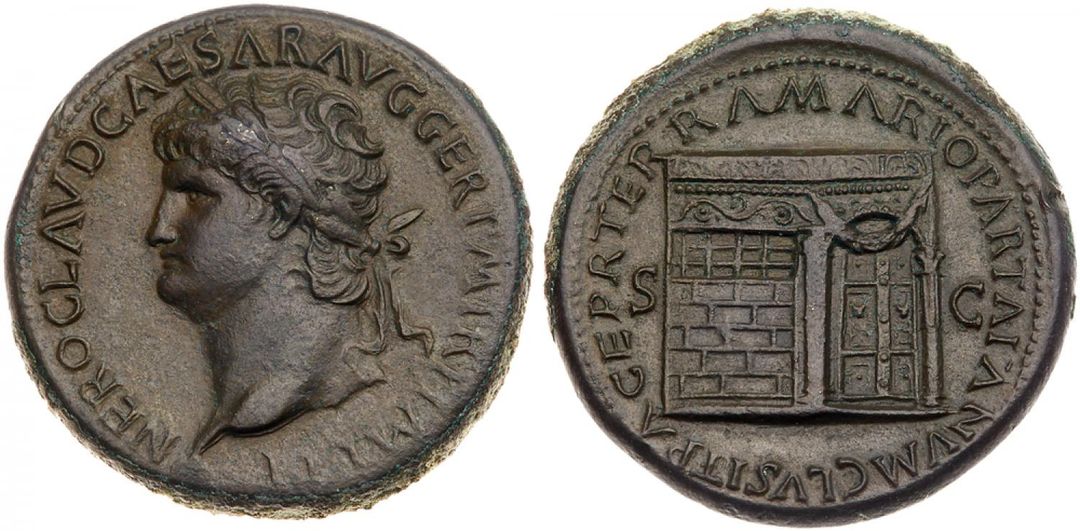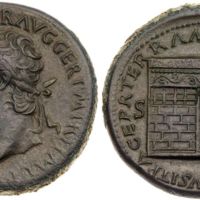Nero 54-68 AD - Temple of Janus Type
Reference Description
Image shown: The New York Sale Auction XL Lot 1205
Notes
MoneyMuseum
Nero was thrilled. He could use this for propaganda! There were huge celebrations, and countless coins were minted celebrating the victory. On the reverse, they showed an image that you would not necessarily associate with Armenia: the Temple of Janus.
Roma Auction XX Lot 555
The War of Armenian Succession, as it became known, commenced in AD 58 when the Parthian king installed his brother Tiridates on the Armenian throne. A strategically important buffer zone, Armenia was a frequent flash-point between the two great powers. Initially, a Roman counter-attack proved successful in removing Tiridates and installing their own claimant to the throne, but the garrison forces left to hold the territory were soon overwhelmed and a humiliating defeat was inflicted on the Romans at Rhandeia. The Roman commander Lucius Caesennius Paetus was recalled as soon as news of this defeat reached the Senate in Rome in AD 63, by which time the Arch of Nero was allegedly already under construction “while the war was yet undecided….in disregard of known facts” (Tac. Ann. 15.18). He was replaced by Gnaeus Domitius Corbulo, an experienced commander then acting as governor of the adjacent province of Syria. Gathering his forces, he re-opened diplomatic negotiations with the Parthians and agreed a settlement whereby Tiridates would remain as king of Armenia, but only when crowned as such by Nero himself.
The New York Sale Auction XL Lot 1205
The reverse legend proclaims that Nero “closed the doors of [the Temple of] Janus with the peace of the Roman people throughout the land and sea” while the reverse type illustrates the temple with its doors closed. Janus was the Roman god of beginnings and endings whose dual aspect was usually indicated by his depiction with two faces. The doors to his temple were traditionally opened to signify declarations of war and closed to indicate the end of hostilities. However, the vastness of the Roman empire and the numbers of enemies on its borders made it a Very rare occasion when the doors of the Temple of Janus were closed. Nero’s closure of the doors is usually associated with the successful campaigns of his general Cn. Domitius Corbulo in the East and the reassertion of Roman influence in Armenia on the border with the Parthian Empire. It is deeply ironic that in the year after Nero celebrated the closure of the doors of Janus the great and bloody Jewish Revolt broke out, showing that peace was indeed a rare commodity in the Roman Empire.
Nero was thrilled. He could use this for propaganda! There were huge celebrations, and countless coins were minted celebrating the victory. On the reverse, they showed an image that you would not necessarily associate with Armenia: the Temple of Janus.
Roma Auction XX Lot 555
The War of Armenian Succession, as it became known, commenced in AD 58 when the Parthian king installed his brother Tiridates on the Armenian throne. A strategically important buffer zone, Armenia was a frequent flash-point between the two great powers. Initially, a Roman counter-attack proved successful in removing Tiridates and installing their own claimant to the throne, but the garrison forces left to hold the territory were soon overwhelmed and a humiliating defeat was inflicted on the Romans at Rhandeia. The Roman commander Lucius Caesennius Paetus was recalled as soon as news of this defeat reached the Senate in Rome in AD 63, by which time the Arch of Nero was allegedly already under construction “while the war was yet undecided….in disregard of known facts” (Tac. Ann. 15.18). He was replaced by Gnaeus Domitius Corbulo, an experienced commander then acting as governor of the adjacent province of Syria. Gathering his forces, he re-opened diplomatic negotiations with the Parthians and agreed a settlement whereby Tiridates would remain as king of Armenia, but only when crowned as such by Nero himself.
The New York Sale Auction XL Lot 1205
The reverse legend proclaims that Nero “closed the doors of [the Temple of] Janus with the peace of the Roman people throughout the land and sea” while the reverse type illustrates the temple with its doors closed. Janus was the Roman god of beginnings and endings whose dual aspect was usually indicated by his depiction with two faces. The doors to his temple were traditionally opened to signify declarations of war and closed to indicate the end of hostilities. However, the vastness of the Roman empire and the numbers of enemies on its borders made it a Very rare occasion when the doors of the Temple of Janus were closed. Nero’s closure of the doors is usually associated with the successful campaigns of his general Cn. Domitius Corbulo in the East and the reassertion of Roman influence in Armenia on the border with the Parthian Empire. It is deeply ironic that in the year after Nero celebrated the closure of the doors of Janus the great and bloody Jewish Revolt broke out, showing that peace was indeed a rare commodity in the Roman Empire.
Collection
Citation
“Nero 54-68 AD - Temple of Janus Type,” Armenian Numismatic Research Organization, accessed January 22, 2025, https://armnumres.org/items/show/1143.


